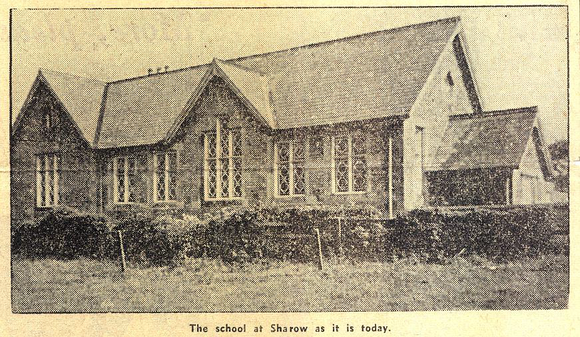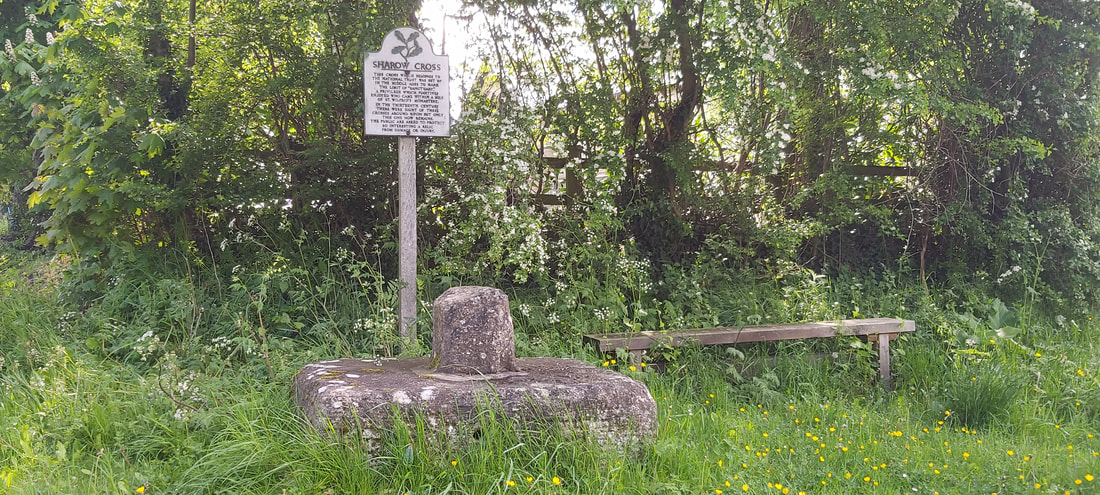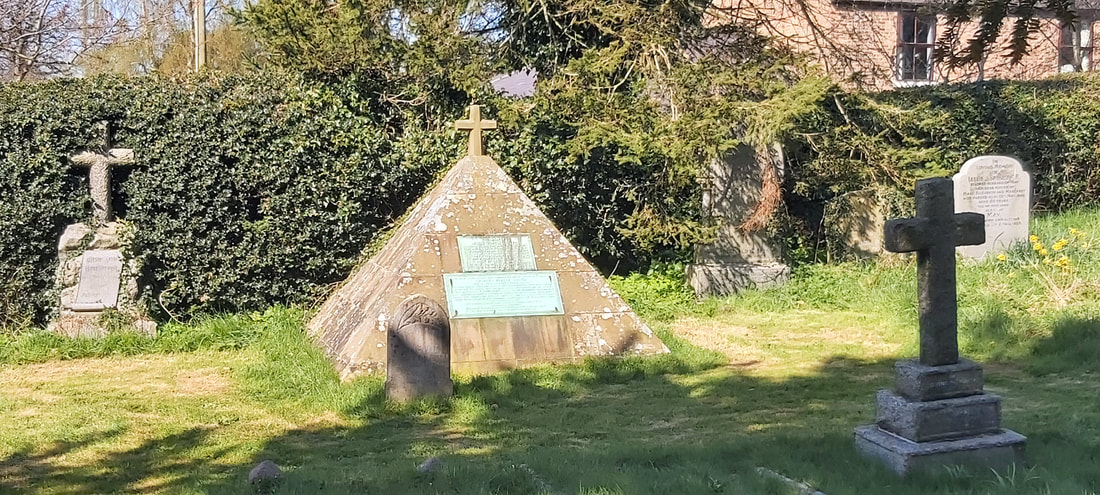Local History
The name Sharow derives from the Old English of 'Scearu' and 'Hōh' which translates as boundary hill-spur or a share/division of a sharply projecting piece of land.
Sharow Cross
|
In 937, King Athelstan created the Sanctuary of Ripon by placing eight crosses on the roads approaching the city. Some of the crosses were given names; Cross of Athelstan, Kangel Cross and Sharow Cross.. The sanctuary was known as the Liberty of St Wilfrid and was maintained by the ecclesiastical body in the city. The boundary waymarkers have all since been removed or destroyed except the remnants of the base of one of the crosses at Sharow, which is now a listed monument. The sanctuary lasted until 1540 when the authorities looking after law and order became secular.
|
The Sanctuary Way Walk is a 10-mile (16 km) circular walk around the city of Ripon. The walk traces a route around the city and has eight trail points at the places where waymarkers used to designate that travellers were within 1-mile (1.6 km) of the cathedral at Ripon and thus afforded The Sanctuary of Ripon. The waymarker at Sharow is the base of one of the crosses that used to mark the edge of the Sanctuary of Ripon. Now looked after by the National Trust, it was the first NT gift in Yorkshire.
Sharow Primary School

In 2005 Sharow Primary School completed a fascinating project on the history of the school - report
In 1825, Elizabeth Sophia Lawrence of Studley Royal gave the Parsonage, a farmhouse called Throstle’s Nest, to the parish. She also donated the master’s house and small schoolroom now known as ‘School House’, (this is the first record of a ‘school’ in Sharow). One record suggests there were seven fee-paying scholars.
In 1825, Elizabeth Sophia Lawrence of Studley Royal gave the Parsonage, a farmhouse called Throstle’s Nest, to the parish. She also donated the master’s house and small schoolroom now known as ‘School House’, (this is the first record of a ‘school’ in Sharow). One record suggests there were seven fee-paying scholars.
Charles Piazzi Smyth and his pyramid
From the St John's Sharrow website.... On the western edge of our churchyard stands an unusual tombstone in the shape of a miniature pyramid, topped with a cross. It commemorates Charles Piazzi Smyth, sometimes known as the pyramid man, and his wife Jessie Piazzi Smyth who accompanied him on many of his expeditions. He has been described as, "Brilliant and Eccentric" but this use of the word 'Eccentric' has been challenged on the basis that is detracts from his remarkable discoveries and inventions. It has been suggested that 'Innovative' would be more accurate and kinder. I am happy to include this as accuracy is essential to the integrity of a document like this.
Charles Piazzi Smyth was born in Naples, Italy on 3rd January 1819 to Admiral and Annarelia Smyth. They named their son Piazzi after his Godfather who was an Italian astronomer. Admiral Smyth was himself an amateur astronomer. So perhaps it's not surprising that Charles Piazza Smyth would eventually study astronomy. It is interesting to note that Admiral Smyth was the maternal Grandfather of Baden-Powell, founder of the Scouting Movement; making Charles uncle of Baden-Powell.
Admiral Smyth eventually set up home in Bedford where he established an observatory enabling his son Charles to develop a knowledge and love of the science of astronomy. In his mid teens Charles gained a position as assistant to Sir Thomas Maclear in the Cape of Good Hope giving him the chance to observe various astronomical spectacles. He worked in Cape Town from 1835 to 1845 and during this period established a reputation for astronomical drawing and the use of photography.
It was in 1845 that Charles Piazzi Smyth was appointed Astronomer Royal for Scotland, a post he held for 43 years, and also Professor of Astronomy at the University of Edinburgh. In 1856 he set out on a scientific voyage cum honeymoon. This took him to the mountain peaks of Teneriffe. It was at this time that he confirmed what Newton had earlier surmised, that benefits accrued from carrying out observations from mountain locations where problems caused by the earth’s atmosphere and cloud could be minimized.
The records of this outstanding scientist seem to be somewhat muddied by the prejudice, even bigotry, of others of his times. But there is no doubt he was a man of great achievement. It is with the Great Pyramid of Gizeh that his name will always be remembered. He was a pioneer of indoor photography and the photographs he took inside the Great Pyramid are some of the earliest known. Amongst his various publications were, 'Our Inheritance in the Great Pyramid' (1864) and 'Life and Work at the Great Pyramid' (1867). He resigned his Fellowship of the Royal Society when they refused to publish his papers on pyramid research; but there are still hundreds of entries under his name in the Royal Society’s Catalogue of Scientific Papers.
He carried out important scientific research in cooperation with Professor A S Herschel and in 1880 he received the Macdougal-Brisbane Prize after constructing a map of the solar-spectrum. Charles advanced the science of Spectroscopy; started the first time signal from Calton Hill; organised over fifty meteorological stations in Scotland; and made numerous astronomical experiments.
In 1888 he resigned his official position, retired to his residence Clova in Ripon and apparently devoted the rest of his life to cloud photography. He died on the 21st of February 1900 and was buried, with his wife, in St John's Churchyard, Sharow
|
In memory of
JESSIE PIAZZI SMYTH Daughter of Thomas Duncan, the dear wife of Charles Piazzi Smyth L.L.D. Ed. Late Astronomer Royal for Scotland Who was his faithful and sympathetic friend and companion Through 40 years of varied Scientific experiences by land and sea abroad as well as at home at 12000feet up in the atmosphere on the wind swept Peak of Teneriffe as well as underneath and Upon the GREAT PYRAMID OF EGYPT Until she fell asleep in the LORD JESUS CHRIST At Clova Ripon on the 24th day of March 1896 aged 80 |
Besides the earthly remains of his lamented wife, lies interred the body of
CHARLES PIAZZI SMYTH Born 3rd January 1819, died February 21st 1900. Astronomer Royal for Scotland from 1845 to 1888, who earned unperishing renown by his journeys to distant lands for Scientific objects, and by his eminent Astronomical and other Scientific Writings and Researches. As bold in enterprise as he was resolute in demanding a proper measure of Public sympathy and respect for astronomy in Scotland he was not less a living emblem of pious Patience under troubles and Afflictions, and he sank to rest, laden with well-earned Scientific Honours a Bright Star in a Firmament of ardent explorers of the works of their Creator. Still achieving, still pursuing, learning to labour and to wail He Prayeth best, who loveth best all things great and small For the dear God who loveth us, He made and loveth all. |
The website of St John's Sharow has more information on the local history of the parish. More information on the Ripon area can be found at Ripon Museums.

